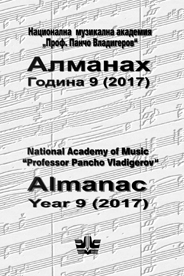Класическо по форма, формалистично по съдържание? Сонатната форма и додекафонията на Константин Илиев във Втората му симфония
Classic in Form, Formalist in Content? Konstantin Iliev’s Sonata Form and Dodecaphony in his Second Symphony
Contributor(s): Patrick Becker (Translator)Subject(s): History, Fine Arts / Performing Arts, Cultural history, Music
Published by: Издателство НМА „Проф. Панчо Владигеров”
Keywords: post-war avant-garde; Bulgarian music; dodecaphony; post-tonal music; sonata form; 20th century music; Konstantin Iliev
Summary/Abstract: Konstantin Iliev thought about his Second Symphony (1951) that it is the first dodecaphonic composition in Bulgaria. However, previous research suggests that the composer might have misunderstood the method of dodecaphony because this work does not represent twelve-tone music in its common understanding. Here, a look at Iliev’sexplicit poetics is insightful. This examination leads to an analysis of the opening movement of Iliev’s Second Symphony: First, the composer’s use of dodecaphony is described. Second, the question is raised, how the post-tonal musical language influences the musical form: How does Iliev compose within the framework of a musical genre, whose form is usually considered as incompatible with post-tonal music? Iliev’s reception of Alois Hába and pre-classical instrumental music proves to be significant influences during this formative time of his artistic development.
Journal: Алманах - Национална музикална академия „Проф. Панчо Владигеров“
- Issue Year: 2018
- Issue No: 9
- Page Range: 183-202
- Page Count: 20
- Language: Bulgarian

